Table of Contents
Mud Turtle Overview
Some aquarium hobbyists prefer keeping their pet turtles as a pastime hobby. Indeed, turtles can make a great addition to a well-designed turtle tank. One of the most preferred freshwater turtle species is the Mud Turtle.
Like many other turtles, this turtle requires similar care, except that it is semi-terrestrial. The small body size of these turtles makes them highly preferred over other turtle species. A small-sized turtle is easy to care for and will not need a large tank.
We think you’ll like: Best Turtle Tanks
It is very rare to find a mud turtle that grows to its maximum body size of five inches in length. These animals are small and compact in overall body size and can be readily reared even in nano tanks.
The turtle can also live in captivity, and it is estimated to live more than fifty years. Experts claim that it can live more than sixty years in the wild. However, the bottom line, if you want yours to live longer, is to give it appropriate care in captivity.
Basic Information
Mud turtles are native to the ponds of Texas and New York. Aquarium hobbyists prefer keeping them because they are smaller in size. Only under rare circumstances does this turtle grow larger than 5 inches.
Mud turtles can be kept outdoors and indoors without worrying about developing potential illnesses. This turtle species likes to spend most of its time walking around and settling at the bottom of a pond. It also likes to stay buried under leaves.
While mud turtles are cute, they are not well-suited for younger children. To keep a mud turtle, you need to have an intermediate skill as they like to live on both land and water.
Below is a quick table that will help you know a few things about mud turtles.
| Information chart | Mud Turtle |
|---|---|
| Scientific name | Kinosternon |
| Family | Kinosternidae |
| Care level | Easy to moderate |
| Temperament | Quiet until provoked |
| Color | Depends on the specie variety |
| Lifespan | 30 to 50 years |
| Size | 3-5 inches |
| Diet | Omnivore |
| Minimum tank size | 25 gallons |
| Temperature | 74-78 degrees Fahrenheit |
| Water conditions | 6.6–7.6 pH |
| Tank mate compatibility | Tetra fish, yellow cichlids, zebrafish |
The Appearance of Mud Turtle

They are super small, with a mature turtle growing to a maximum of five inches. It must be noted that there are usually various types of mud turtle species, and therefore their appearances usually vary. Some varieties may look similar even to the musk turtle species.
They have a carapace that is not as dome-shaped as other varieties of turtles. The shell of a healthy mud turtle is usually oval-shaped exhibiting dark brown coloration, although this may vary depending on the turtle’s region.
Varieties of Mud Turtle
Eastern Mud Turtle
This mud turtle version measures only 3-4 inches. It’s popular among fish tank keepers because it looks different. It has a dark and smooth shell, olive-brown with no pattern. Also, it has 11 plates instead of 12.
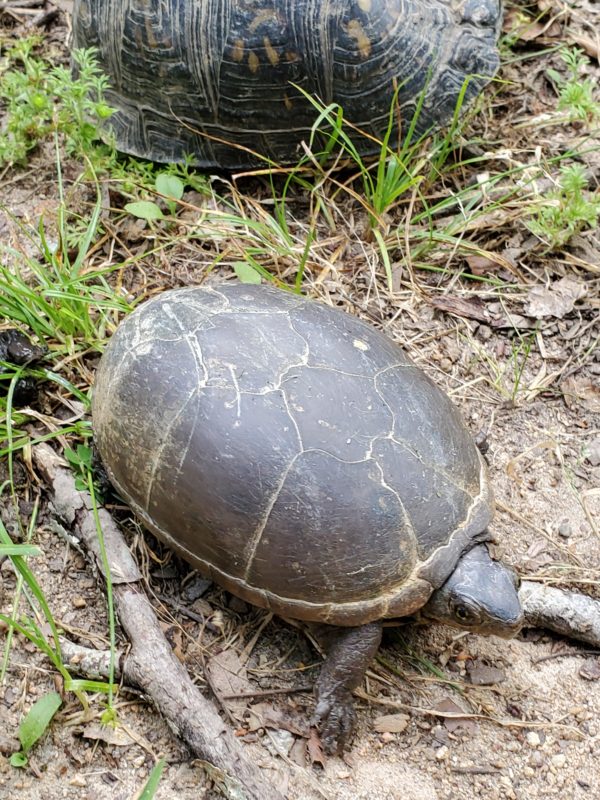
The males of Eastern Mud Turtles have a spine on the tip of their tail and a scaly patch on the inside of their legs.
Mississippi Mud Turtle
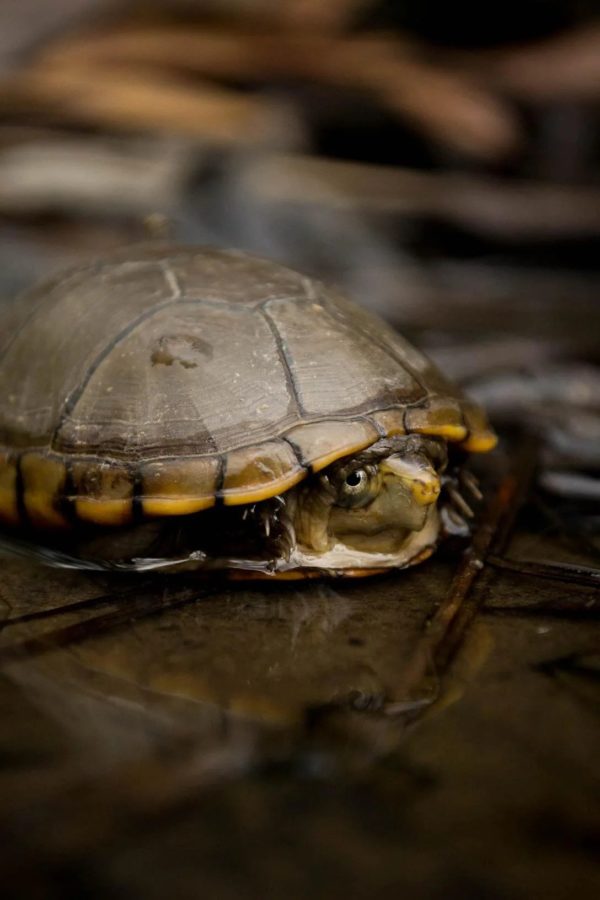
The Mississippi Mud Turtle somewhat resembles the Eastern Mud Turtle. The only difference is that the Mississippi Mud Turtle has light-colored lines on both sides of its head. Also, this turtle ranges in color from yellow to a deeper tan.
Striped Mud Turtle
The Striped Mud Turtle is a commonly found and easily recognized mud turtle species. Usually, this one is smaller than other mud turtle varieties.
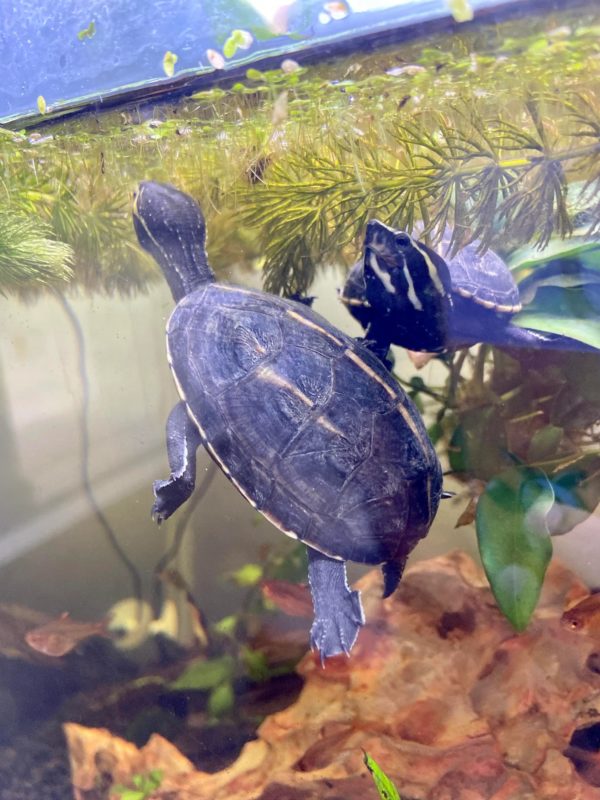
One can identify a Striped Mud Turtle by seeing light color stripes running vertically throughout the length of the shell. And there’s also a single stripe between its eyes.
Yellow Mud Turtle
Just like other mud turtles, this one also has a darker shell in olive-brown color. But it has a yellow color on its head, side of neck, and throat. This yellow color can also extend to the shell, making the upper part of the head appear darker. This mud turtle species can grow up to 4 inches.
The Lifespan of Mud Turtle
The typical lifespan of a mud turtle is 50 years. If you want to adopt one, you need to commit. And if you can’t offer proper care to the mud turtle, try to find a new home for it.
Remember that a mud turtle kept in captivity can find it difficult to survive in the wild. Plus, they can become an invasive species.
Size of Mud Turtle
Typically, mud turtles can grow up to 3 inches on the lower end and 6 inches for the larger species. You can easily take care of a smaller mud turtle than the bigger one.
Natural habitat and Origin
The Mud turtle likes inhabiting freshwater ponds with vegetation or those even without. In most instances, because the mud turtle is usually shy and likes to hide, you will find it living in heavily vegetated ponds of water. It enables it to have many places to hide when it feels threatened or simply wants to be alone and not be disturbed.
The spring-fed streams are the other places these turtles usually inhabit in the wild—these turtles like clean waters with sufficient oxygen levels that make them thrive better.
In the wild, you can find turtles in sandy or muddy areas of the water body. Occasionally, when the environment outside is not conducive for the animal, it is known to burrow deep into the mud to escape the ravages of the hostile weather until the next optimal season.
These turtles are native to the Americas spread out across the vast region, including the US, Mexico, South America, and Central America.
Mud Turtle Care and Tank Setup
Caring for the mud turtle is easy and if all the recommended conditions are provided it will lead a healthy life. It is better to provide sufficient space to it if you are going to keep it in a captive tank. For one or two turtles housed together, a tank that has got a minimum of 48 gallons is even better.
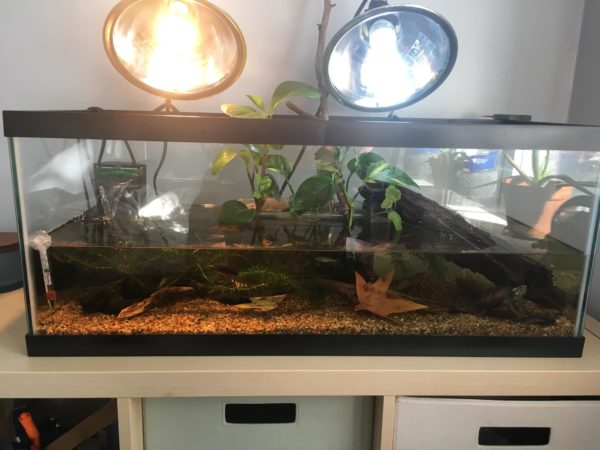
Because mud turtles like to bask, providing a basking spot for them is advised. A basking area can be designed within the enclosure. A good method of providing heat on the basking area is using a heat lamp which should be placed above. The heat lamp needs to be set to ideal temperature conducive for the survival of the turtle. The heat can be set to at least 90 degrees Fahrenheit.
Mud Turtle Tank Size and Specifications
This section covers the optimum tank shape, optimum tank size, filter type, and how many turtles we can keep together.
Optimum Tank Size for Mud Turtle
The recommended tank size for a mud turtle is 25 gallons. This much space will help your turtle swim, dive, and roam around without issues. If it is a female mud turtle, you can consider getting a bigger tank.
Tank Shape for Mud Turtle
An ideal tank shape for mud turtles is rectangular as it gives them enough space to float around.
Filter Type
You need a water filter to keep the mud turtle tank water clean and flowing. For this, you can use a canister or submersible filter. These filters can keep the water in good condition, preventing infection and illness.
Substrate
Speaking of the substrate, you do not need to add anything specific to the tank. But if you want, you can lay gravel to give a natural feel. Ensure that the substrate you choose doesn’t float or mix with the water.
Water Parameter for Mud Turtle
This section covers water flow rate, hardness, and water temperature information.
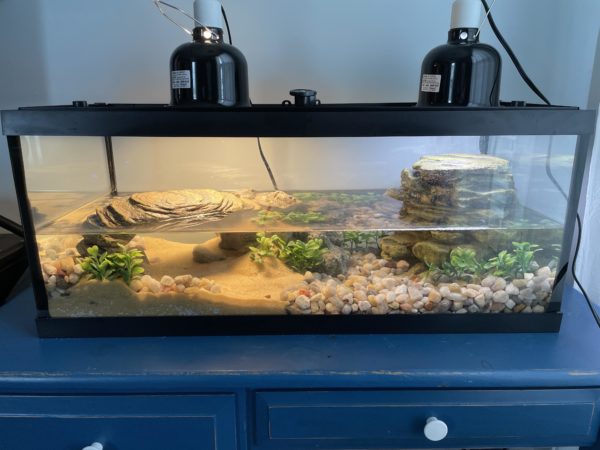
Water Temperature
The ideal water temperature for mud turtles is between 80 – 85 degrees Fahrenheit but should not exceed the 70 degrees Fahrenheit mark.
As for the water temperature, you will need a heater to help regulate the water temperature between 70 – 75 degrees Fahrenheit.
pH Level
The perfect water pH level for mud turtles is 6.6 to 7.6. You can do a partial water change to ensure that your mud turtle gets a good living environment.
Mud Turtle Tank Landscape
To set up a mud turtle tank, you need to have a 25 gallons tank. Keep the proportion of your water as half water and half land. Doing this will give enough space to your turtle for swimming and roaming around. The water depth should be twice the length of your mud turtle.
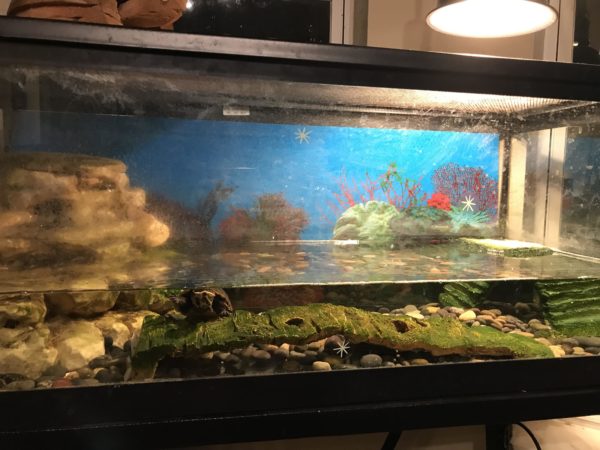
Then add substrates, like gravel, and the right kind of filter. After that, add proper lighting. Plant decorations carefully and let your mud turtle enjoy its new home.
Best Plants for Mud Turtle Tanks
You would not like your mud turtle to live in an empty tank. That’s why you are advised to add real plants to the tank. But you should not add random plants. Instead, you must choose one from the below list.
- Java fern
- Java moss
- Java fern Microsporum bundle
- Anubias nana plant potted
- Anubias bundle
- Brazilian pennywort bundle
- Water sprite Ceratopteris thalictroides
- Hygrophila difformis water wisteria
All these plants are capable of growing perfectly in low lighting scenarios. Also, they are hardy and have a good growth rate.
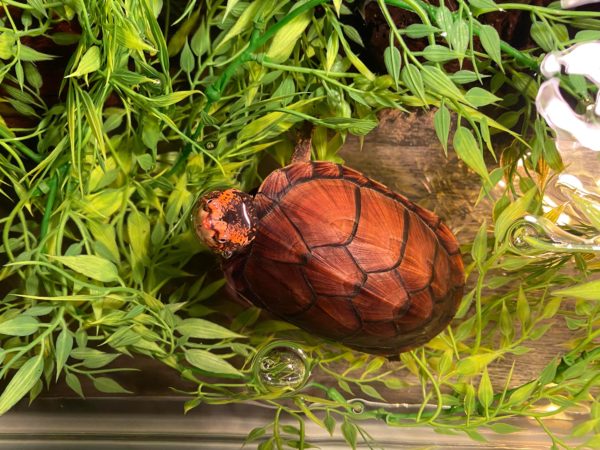
Worst Plants for Mud Turtle Tanks
Did you know that contact with certain kinds of plants could result in burning, swelling, and pain among turtles? Below is a complete list of the worst plants that you should keep away from the turtle tank.
- Arrowhead vine
- Swiss cheese plant
- Umbrella tree
- Dumb cane
- Elephant’s ear
- Firethorn
- Calla Lily
- Begonia
Decoration for Mud Turtle Tanks
As a part of the decoration, you can add several hiding spots in the tank. Whenever the turtle gets stressed, it can hide in the hiding spots and feel safe.
Aquarium plants and driftwood can offer a great cover to the mud turtle. Besides this, you can put some common decorative items that you can get in the aquarium store.
Lighting for Mud Turtle Tanks
You are advised to use a UVB light bulb for the turtle’s shell health. It can be placed over the animal’s enclosure and be put on for at least 12 hours every day.
If your turtle is a household outdoors, then natural sunlight is sufficient. But if it is an indoor household, you would have to add artificial lighting.
Ensure that the mud turtle tank is not directly exposed to the sunlight as it easily overheats the tank and water.
Feeding Mud Turtle
Like other freshwater turtles, this turtle is omnivorous, meaning it eats both plant products and other small animals. This fact makes the turtle very easy to feed and care for. It can be offered the commercially produced pellet turtle feed.
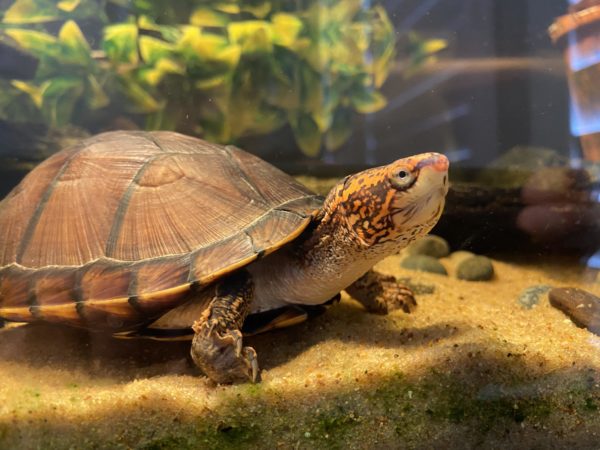
Just ensure that you provide the animal with sufficient calcium and vitamin supplements. Remember, proper nutrition is usually vital for the overall good health of the animal, especially if it is being kept in captivity.
Best Diet for Mud Turtle
Honestly, turtles can eat anything smaller than them, like arthropods, fish, eggs, etc. They are not picky eaters. Also, they occasionally eat algae and plants.
That means you can include the following thing in your mud turtle’s diet.
- Snails
- Fish
- Insects
- Green leafy vegetable
- Variety of worms
You must offer them fresh green vegetables. You can even add calcium supplements for baby mud turtles. And for adults, do the same three times a week. Also, you must feed them one protein meal a day.
How Often to Feed Mud Turtles?
It is advisable to feed mud turtles 2 to 3 times a week. And if the mud turtle lives indoors, don’t forget to add calcium to the diet.
Mud Turtle Behavior and Temperament
Undoubtedly, mud turtles look cute but do not get deceived by their innocent looks. If you think that they are friendly and docile, you are sadly mistaken.
If you make your turtle feel nervous or provoke him, it may bite you. That’s why you must not touch the turtle until necessary. Also, mud turtles are known to secret foul liquid to scare off predators.
Are Mud Turtles Lone or Societal in Nature?
Mud turtles can live together as far as all the turtles living together are adults or juveniles.
It is a highly social animal that will readily share a tank with other turtles of its likeness. It has also been established to cope well with other small turtles such as musk turtles. Due caution however needs to be observed when you need to hold the turtle because they will bite when they are threatened or stressed.
Their bite can cause injury and therefore small children need to be kept away from them as much as possible. They also foul smelling liquid from their glands which can be irritating so it is best to keep them feeling relaxed and safe.
Breeding Mud Turtle
The female of the Mud turtle is known to mature in its sixth or eighth year. Vitellogenesis usually begins in the early fall and will continue until the next season of nesting. With proper conditions set for the animals, they will breed and produce new young ones without much ado, even in captivity.
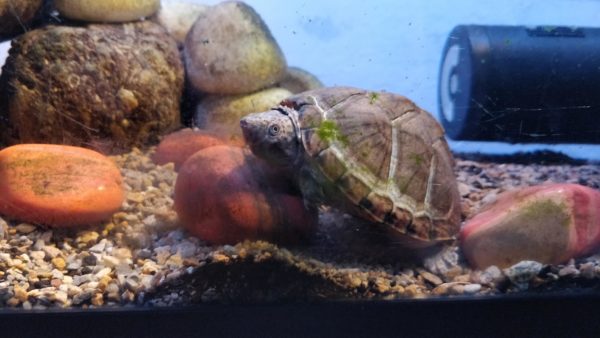
The egg incubation period for mud turtles is 2 to 3 months. Their regular breeding season is from April to November.
Mud Turtle Breeding Level?
Breeding mud turtle requires patience but if you have all the necessary information, you can easily breed them.
Mud Turtle Sexual Dimorphism
To distinguish between males and females, you can see their size.
Usually, the male turtle is bigger than the female. Also, they have larger eggs, tails, and heads. Also, the tailor male mud turtle has a bony spine at the end, and they have scaly patches on the inside of their legs.
Mud Turtle Common Disease and their Treatment
While mud turtles are strong, they are likely to develop some health complications:
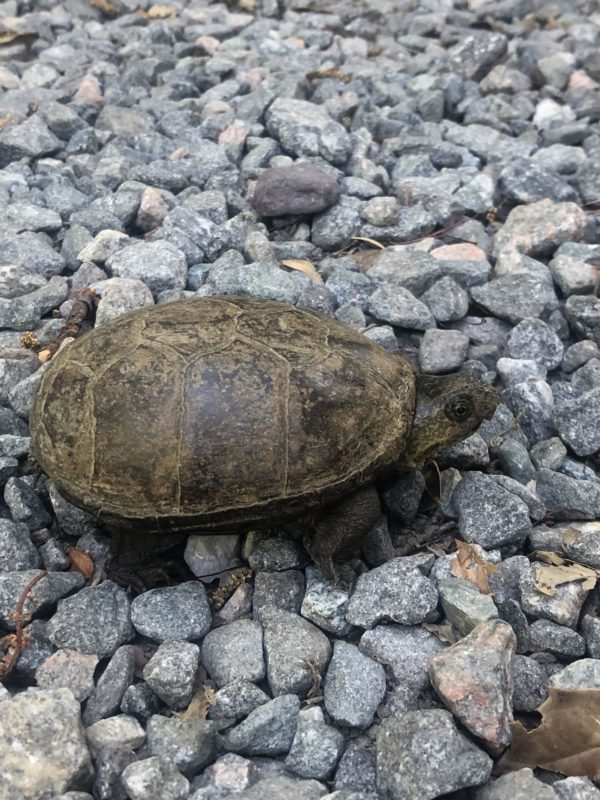
- Shell problems
- Nutrient deficiency
- Cuts, and bruises
If you ever notice that your mud turtle is not doing well, you must offer it immediate and proper care.
Is Mud Turtle Right For You?
Mud turtle is a popular turtle breed that people like to keep in their homes. And since these turtles are easy to care for, beginners like keeping them. That means mud turtles are right for you.
FAQs
Do mud turtles bite?
Mud turtles are generally calm and silent turtle species who like minding their own business. But if you provoke them, they will turn on their grouchy side and bite.
Does a mud turtle Sleep in the dark?
Honestly, they don’t need darkness to sleep. But if you want to keep your pet mud turtle happy, try to offer it an equal amount of light and darkness in a day.
How fast does a mud turtle grow?
If given proper care and the right kind of food, you can expect your mud turtle to grow 2 to 3 inches in a very short time.
Conclusion
As more and more people have started keeping turtles as pets, mud turtles are gaining huge popularity. Also, they are easy to care for and are interesting species. But if you want to keep your mud turtle happy, you need to remember a few things.
First things first, keep the water clean. Also, provide them with proper nutrient-rich food, keeping them healthy. And add multiple plants in their tank for cover.
No related posts.
